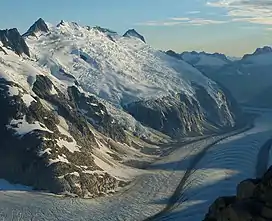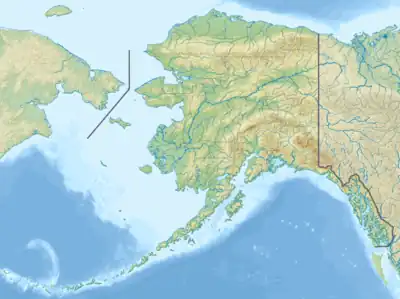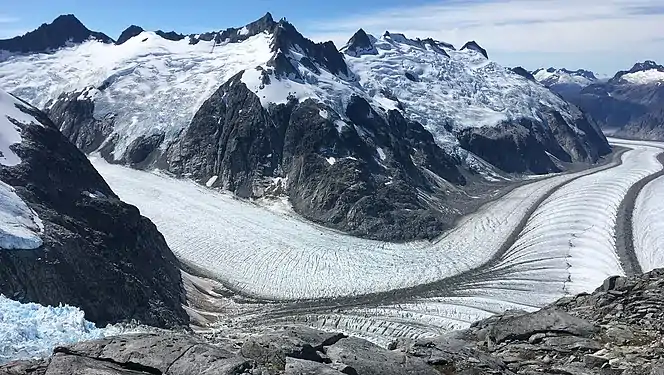| Mount Blachnitzky | |
|---|---|
 Mt. Blachnitzky from the northeast | |
| Highest point | |
| Elevation | 6,552 ft (1,997 m)[1] |
| Prominence | 602 ft (183 m)[1] |
| Isolation | 3.7 mi (6.0 km)[1] |
| Coordinates | 58°47′48″N 134°23′44″W / 58.79667°N 134.39556°W[2] |
| Geography | |
 Mount Blachnitzky Location in Alaska | |
| Location | Tongass National Forest Juneau Borough Alaska, United States |
| Parent range | Boundary Ranges |
| Topo map | USGS Juneau D-2 |
| Climbing | |
| First ascent | 2004, Keith Daellenbach and party |
| Easiest route | class 3 south ridge |
Mount Blachnitzky is a 6,552 ft (2,000 m) mountain summit in the city and borough of Juneau, Alaska, United States. It is a part of the Boundary Ranges of the Coast Mountains in western North America. It is located between Gilkey Glacier and Avalanche Canyon; it is named after Klaus Blachnitzky (1921-1988), a surveyor, geodesist, and explorer of the Juneau Icefield.[2] Mr. Blachnitzky was the head surveyor for the Juneau Icefield Research Program. Much of his work was conducted in the vicinity of this summit. In August 1988, having completed almost two seasons instructing student surveyors and scientists in the science and practice of terrestrial field surveying and geodesy, he was killed when he slipped from a rock cleaver on the slope of Vaughan Lewis Glacier.[2] The site of his death is four miles from the mountain named in his honor. In 2004, four climbers made a memorial climb of the previously unclimbed summit, leaving at the peak some surveying mementos of Mr. Blachnitzky's life.[2] That first ascent was made by Scott McGee, Keith Daellenbach, Charles Daellenbach, and Fred Skemp III, on June 30, 2004, via the southwest cirque/south ridge.[3] The mountain's name was officially adopted in 2007 by the U.S. Board on Geographic Names.
Climate
Based on the Köppen climate classification, Mount Blachnitzky has a subarctic climate with cold, snowy winters, and mild summers..[4] Most weather fronts originate in the Pacific Ocean, and travel east toward the Coast Mountains where they are forced upward by the range (Orographic lift), causing them to drop their moisture in the form of rain or snowfall. As a result, the Coast Mountains experience high precipitation, especially during the winter months in the form of snowfall. Temperatures can drop below −20 °C with wind chill factors below −30 °C. The month of July offers the most favorable weather for viewing and climbing Mount Blachnitzky.
See also
References
- 1 2 3 "Mount Blachnitzky, Alaska". Peakbagger.com. Retrieved 2020-04-10.
- 1 2 3 4 "Mount Blachnitzky". Geographic Names Information System. United States Geological Survey, United States Department of the Interior. Retrieved 2015-02-10.
- ↑ Keith Daellenbach, First Ascent: Mt. Blachnitzky and Peak 6500' on Juneau Icefield, Mazama 2004, page 13
- ↑ Peel, M. C.; Finlayson, B. L.; McMahon, T. A. (2007). "Updated world map of the Köppen−Geiger climate classification". Hydrol. Earth Syst. Sci. 11. ISSN 1027-5606.
Gallery
 Gilkey Glacier. Mt. Blachnitzky to right of center
Gilkey Glacier. Mt. Blachnitzky to right of center.jpg.webp) Gilkey Glacier, Mt. Blachnitzky to right, Mt. Queena centered. Circa 1955
Gilkey Glacier, Mt. Blachnitzky to right, Mt. Queena centered. Circa 1955
External links
- Mount Blachnitzky: weather forecast